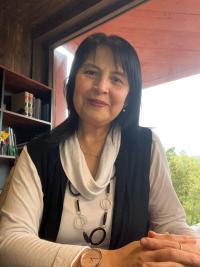You are here
In the pursuit of environmentally and socially sustainable housing solutions
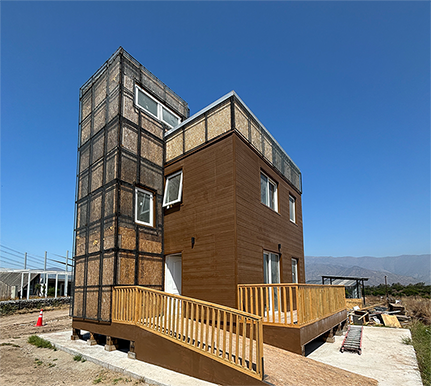
From design strategies to construction solutions, material selection, energy performance in the use phase, and other variables, to the end of its useful life and waste generation. All of these factors must be evaluated in the context of ensuring the long-term sustainability of a house.
Dr. Claudia Muñoz Sanguinetti, a leading expert in sustainable habitat, is part of the initiative that is building the first printed housing in Latin America at the Universidad del Bío-Bío. She is also a member of the GWR Project team, Greywater Reuse, led by the Usach.
Dr. Claudia Muñoz Sanguinetti, an expert in sustainable habitat, is working on two important projects. She is participating in an initiative to build the first 3D-printed housing prototype in Latin America, a milestone led by the Universidad del Bío-Bío. She is also working on the GWR Project, which is centered at the Usach and focused on generating a pilot house equipped with a gray water treatment and reuse system. Two innovative developments share a common goal: to identify environmentally and socially sustainable housing solutions.
Dr. Claudia Muñoz, Director of Research and Artistic Creation at Universidad del Bío-Bío
To achieve this condition, Dr. Claudia Muñoz outlines some of its characteristics: "The foundation of our approach is laid during the design stage, where we meticulously consider the environmental conditions, characteristics, and surrounding environment. Consequently, appropriate construction systems and materials are selected for better environmental performance and lower energy consumption of the house. These include natural lighting, orientation, types of insulation, or cooling conditions, depending on the area in which it is located. The design strategy should encompass all of these bioclimatic criteria, incorporating life cycle thinking. It is essential to emphasize that the strategy should address not only the construction stage but also the use stage, including the potential need for reconditioning to extend the building's lifespan. Additionally, the strategy should consider the eventual deconstruction of the structure at a later date".
For this stage, she argues that it would be possible to "design housing that can be disassembled, recoverable", seeking the least environmental impact and thinking about the circularity of buildings.
Dr. Muñoz, reflecting on the analysis being carried out at the Universidad del Bío-Bío, where the International Seminar on Sustainable Industrialized Housing has just been held, notes "that we are at a turning point to rethink our housing practices. At the University del Bío-Bío, we have a long-standing commitment to sustainable building. We are proud to say that our CITEC-UBB research center and postgraduate programs are highly specialized in this field. In fact, we offer a master's degree and a doctorate specifically in sustainable habitat from the Faculty of Architecture, Construction and Design (Farcodi)".
As she explains, "the current focus is on innovation for sustainability, including printed construction, which reduces construction times and waste, minimizes ecological footprints, and enhances the thermal envelope to improve the comfort of the house. We are currently studying structural issues, but always from the point of view of the lowest possible environmental impact".
The integration of universities and technology
Concurrent with the development of the printed housing prototype at the Universidad del Bío-Bío, the Technological Center for Innovation in Construction (CTEC) in Santiago (Laguna Carén) is advancing the Sustainable Social Housing pilot house. This house is equipped with integrated technologies for treating and reusing gray water, featuring an irrigation system for walls and green roofs.
"The pilot house, conceived within the GWR Project, is notable for its incorporation of strategies for the efficient use of a relevant resource: water. The circularity of water, applied to the irrigation of walls and green roofs, among other uses, will allow them to function as a natural acoustic and thermal insulating material, improving the energy performance of the house", explains Dr. Muñoz.
According to the academic, the incorporation of green roofs and walls is not only an aesthetic addition to housing, but it is also projected to be a feature of neighborhoods in the future. This addition "would contribute to improving air quality and reducing heat islands in increasingly hot cities, where the pavement and concrete of buildings project heat. This represents a sustainable alternative to lower radiation with these green installations".
The potential exists to integrate technological advancements in housing, leveraging the achievements of university projects in this field. With regard to printed housing, Dr. Muñoz emphasizes the rapid construction process. "We have the capacity to print a wall daily. This can be a significant contribution to the housing deficit, both in terms of construction time and quality, given that we are discussing concrete housing".
She adds that another relevant attribute "is that thermal insulation can be managed, because it has an air chamber, which improves interior comfort, reduces time, the amount of waste, and does not require molding, so there is a great final saving of resources".
"Given the rapid advancements in technology, the challenge lies in integrating this progress into the fields of architecture, construction, and engineering", concludes Dr. Claudia Muñoz Sanguinetti.
Fuente: Revista Ecociencias
News
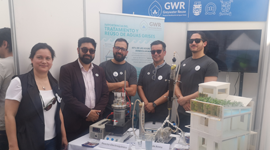 GWR project at the Environmental Fair
GWR project at the Environmental Fair
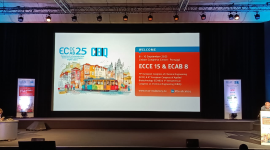 GWR researcher participates in major science conference in Portugal
GWR researcher participates in major science conference in Portugal
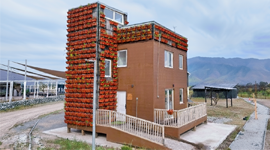 The GWR Project has achieved the technological integration of gray...
The GWR Project has achieved the technological integration of gray...


